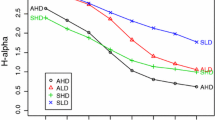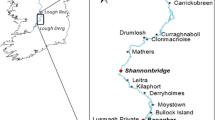Abstract
Weirs are low-level dams used in Louisiana’s coastal marshes to improve habitat quality for ducks and furbearers; however, some ecologists question whether weir management inhibits soil drainage and thereby negatively affects the emergent plant community. We compared the emergent plant communities of unmanaged marsh and marsh that was weir managed since 1958 at Marsh Island, Louisiana to test for management effects. Two data sets were analyzed: 4 permanent transects sampled 8 times between 1958 and 1988, and 44 random transects sampled in 1987. If weir management inhibited soil drainage, differences between weir managed and unmanaged marsh should have been similar to differences between naturally poorly drained and better drained marsh. Poorly drained marsh had lower species richness and diversity than better drained marsh, and poorly drained and better drained marsh differed in the importance of 4 major plant species. Neither species richness, species diversity index, major plant species, nor vegetative cover differed between weir managed marsh and unmanaged marsh in either data set. Analyses indicated that 4 minor species were negatively affected, and 2 were positively affected by weir management, but those results were not consistent in both data sets. Species richness and diversity index were negatively related to the frequency of nutria (Myocastor coypus), but species richness was positively related to the frequency of muskrats (Ondatra zibethicus). Incorrect conclusions would have been reached if variation in herbivore activity had not been noted. Although management may affect other marshes differently, any differences in emergent plant community structure between weir managed marsh and unmanaged marsh at Marsh Island are less than observed differences between naturally well-drained and poorly-drained marsh. The lack of a management effect was attributed to the lack of substantial soil drainage even in unmanaged marsh.
Similar content being viewed by others
Literature Cited
Agosta, K. 1985. The effect of tidally induced changes in the creekbank water table on pore water chemistry. Estuarine, Coastal and Shelf Science 21:389–400.
Babcock, K.M. 1967. The influence of water depth and salinity on wiregrass and saltmarsh grass. M.S. Thesis. Louisiana State University. Baton Rouge, LA, USA.
Berry, W.L. and G.J. Voisin. 1989. One company’s experiences with wetlands conservation. p. 242–246.In W.G. Duffy and D. Clark (eds.) Marsh management in coastal Louisiana: effects and issues—proceedings of a symposium. U.S. Fish and Wildlife Service and Louisiana Department of Natural Resources. U.S. Fish and Wildlife Service Biological Report 89(22).
Canfield, R.H. 1941. Application of the line intercept method in sampling range vegetation. Journal of Forestry 39:388–394.
Chabreck, R.H. 1968. Weirs, plugs and artificial potholes for the management of wildlife in coastal marshes. p. 178–192.In J.D. Newsom (ed.) Proceedings of the 1st Coastal Marsh and Estuary Management Symposium. Louisiana State University, Division Continuing Education, Baton Rouge, LA, USA.
Chabreck, R.H. 1970. Marsh zones and vegetative types in the Louisiana coastal marshes. Ph.D. Dissertation. Louisiana State University. Baton Rouge LA, USA.
Chabreck, R.H. and R.E. Condrey. 1979. Common vascular plants of the Louisiana marsh. Sea Grant Publication No. LSU-79-003. Louisiana State University Center for Wetland Resources, Baton Rouge LA, USA.
Chabreck, R.H. and C.M. Hoffpauir. 1962. The use of weirs in coastal marsh management in Louisiana. Proceedings of the Annual Conference Southeastern Association of Game and Fish Commissioners 16:103–112.
Chabreck, R.H., R.J. Hoar, and W.D. Larrick, Jr. 1979. Soil and water characteristics of coastal marshes influenced by weirs. p. 129–145.In J.W. Day, D.D. Culley, R.E. Turner, and A.J. Mumphrey, Jr. (eds.) Proceedings of the Third Coastal Marsh and Estuary Management Symposium. Louisiana State University Division of Continuing Education, Baton Rouge, LA, USA.
Chabreck, R.H. and G. Linscombe, 1978. Vegetative type map of the Louisiana Coastal Marshes. Louisiana Department of Wildlife and Fisheries, Baton Rouge, LA, USA.
Chabreck, R.H., J.R. Love, and G. Linscombe, 1981. Foods and feeding habits of nutria in brackish marsh in Louisiana. Proceedings of the Worldwide Furbearer Conference 1(1):531–543.
Chabreck, R.H. and L.L. Narcisse. 1981. Effects of water depths on growth of three-cornered grass. Center for Wetland Resources, Louisiana, State University. Sea Grant Publication No. LSU-T-81-002.
Day, R.H., R.K. Holz, and J.W. Day, Jr. 1990. An inventory of wetland impoundments in the coastal zone of Louisiana, USA: historical trends. Environmental Management 14:229–240.
DeVoe, M.R. and D.S. Baughman. 1989. Research and policy issues regarding coastal wetland impoundments: lessons learned
in South Carolina, p. 98–106.In Duffy, W.G., and D. Clark (eds.) Marsh Management in Coastal Louisiana: Effects and Issues— Proceedings of a Symposium. U.S. Fish and Wildlife Service and Louisiana Department of Natural Resources. U.S. Fish Wildlife Service Biological Report 89(22).
DeLaune, R.D., C.J. Smith, and W.H. Patrick, Jr. 1983. Relationship of marsh elevation, redox potential, and sulfide toSpartina alterniflora productivity. Soil Sciences Society of America Journal 47:930–935.
Dirzo, R. 1984. Herbivory: a phytocentric overview p. 141–165in R. Dirzo and J. Sarukhan (eds.) Perspectives on Plant Population Ecology. Sinauer Associates Inc. Publishers, Sunderland MA, USA.
Eleuterius, L.N. and C.K. Eleuterius. 1979. Tide levels and marsh zonation. Bulletin of Marine Science 29:394–400.
Harris, V.T. and F. Webert. 1962. Nutria feeding activity and its effect on the marsh vegetation in southwestern Louisiana. United States Fish and Wildlife Service Special Report on Wildlife 64.
Hemond, H.F. and J.L. Fifield. 1982. Subsurface, flow in salt marsh peat: a model and field study. Limnology and Oceanography 27: 126–136.
Hess, T.J. 1975. An evaluation of methods for managing stands ofScirpus olneyi. M.S. Thesis. Louisiana State University. Baton Rouge LA, USA.
Hindman, L.J. and V.D. Stotts. 1989. Chesapeake Bay and North Carolina sounds, p. 27–55.In L.M. Smith, R.L. Pederson, and R.M. Kaminski (eds.). Habitat Management for Migrating and Wintering Waterfowl in North America. Texas Tech University Press. Lubbock, TX, USA.
Huh, O.K., L.J. Rouse, H.H. Roberts, S.A. Hsu, and D.A. Rickman. 1989. Cold front passages and the response of coastal water and sediment: Mississippi Delta Plain Region, USA.In. U.S. Fish and Wildlife Service and the State of Louisiana. Abstracts from the 3rd annual workshop on remote sensing and geographic information systems for coastal management in Louisiana. U.S. Fish and Wildlife Service, Washington, DC, USA. NWRC open file report 89-01.
Junkin, G.M. 1989. Effects of water management on selected biotic communities in a floating freshwater marsh. M.S. Thesis. Louisiana State University. Baton Rouge, LA, USA.
Keyser, P.D. 1984. Movement patterns of muskrats in a Louisiana coastal marsh. M.S. Thesis. Louisiana State University, Baton Rouge, LA, USA.
King, G.M., M.J. Klug, R.G. Weigert, and A.G. Chalmers. 1982. Relation of soil water movement and sulfide concentration toSpartina, alterniflora production in a Georgia salt marsh. Science 218:61–63.
Larrick, W.D. 1975. The influence of weirs on the vegetation of coastal marshes of Louisiana. M.S. Thesis. Louisiana State University, Baton Rouge, LA, USA.
Louisiana Department of Wild Life and Fisheries. 1946. First Biennial Report. 1944–1945. Louisiana Department of Wild Life and Fisheries. New Orleans, LA, USA.
Louisiana Wild Life and Fisheries Commission. 1954. Biennial Report, 1952–1953. Louisiana Wild Life and Fisheries Commission. New Orleans, LA, USA.
Louisiana Wild Life and Fisheries Commission. 1960. Biennial Report, 1958–1959. Louisiana Wild Life and Fisheries Commission. New Orleans, LA, USA.
Lynch, J.J., T. O’Neil, and D.W. Lay. 1947. Management significance of damage by geese and muskrats to gulf coast marshes. Journal of Wildlife Management 11:50–76.
Meeder, J. 1989. Comparisons of salinity, hydrology, and vegetation characteristics between free-flowing and semi-impounded intermediate to brackish tidal marsh systems. p. 131–141.In W.G. Duffy and D. Clark (eds.) Marsh management in coastal Louisiana: effects and issues—proceedings of a symposium. U.S. Fish and Wildlife Service and Louisiana Department Natural Resources. U.S. Fish Wildlife Service Biological Report. 89(22).
Mendelssohr, I.A., and K.L. McKee. 1988.Spartina alterniflora die-back in Louisiana: time-course investigations of soil waterlogging effects. Journal of Ecology 76:509–521.
Newton, Jr., M.B. 1972. Atlas of Louisiana, A Guide for Students. Geoscience Publications, Louisiana State University. Baton Rouge, LA, USA.
Nyman, J. A., M. Carloss, R. D. DeLaune, and W. H. Patrick, Jr. 1993. Erosion rather than plant dieback as the mechanism of marsh loss in an estuarine marsh. Earth Surface Processes and Landforms 18: (in press).
Nyman, J.A., R.H. Chabreck, and G. Linscombe. 1990. Effects of weir management on marsh loss, Marsh Island, Louisian, USA. Environmental Management 14:809–814.
O’Neil, T. 1949. The muskrat in the Louisiana coastal marshes. Publication Federal Aid Section, Louisiana Wildlife and Fisheries Commission, New Orleans, LA, USA.
Orton, E.W. 1959. A geological study of Marsh Island, Iberia Parish, Louisiana. Louisiana Wild Life and Fisheries Commission. New Orleans, LA, USA.
Overton, W.S. and D.E. Davis. 1969. Estimating the numbers of animals in wildlife populations. p. 403–495In R.H. Giles (ed.) Wildlife Management Techniques (third edition). The Wildife Society, Washington, DC, USA.
Palmisano, A.W. 1967. Ecology ofScirpus olneyi andScirpus robustus in Louisiana coastal marshes. M.S. Thesis, Louisiana State University, Baton Rouge, LA, USA.
Pezeshki, S.R. and R.D. DeLaune. 1988. Carbon assimilation in contrasting streamside and inlandSpartina, alterniflora salt marsh. Vegetatio 76:55–61.
SAS Institute Inc. 1987. SAS/STAT Guide for personal computers, version 6 edition. SAS Institute Inc., Cary, NC, USA.
Simpson, E.H. 1949. Measurement of diversity. Nature 163:688.
Smith, L.M., R.L. Pederson, and R.M. Kaminski (eds.). 1989. Habitat Management for Migrating and Wintering Waterfowl in North America. Texas Tech University Press. Lubbock, TX, USA.
Snedecor, G.W. and W.G. Cochran, 1989. Statistical Methods. Eighth Edition. Iowa State/University Press, Ames, IA, USA.
Spiller, S.F. and R.H. Chabreck. 1975. Wildlife populations in coastal marshes influenced by weirs. Proceedings of the Annual Conference of the Southeastern Association of Game and Fish Commissioners 29:518–525.
Steele, R.G.D. and J.H. Torrie. 1980. Principles and Procedures of Statistics a Biometrical Approach. McGraw-Hill Inc., New York, NY, USA.
Author information
Authors and Affiliations
Rights and permissions
About this article
Cite this article
Nyman, J.A., Chabreck, R.H. & Kinler, N.W. Some effects of herbivory and 30 years of weir management on emergent vegetation in Brackish Marsh. Wetlands 13, 165–175 (1993). https://doi.org/10.1007/BF03160877
Received:
Revised:
Accepted:
Issue Date:
DOI: https://doi.org/10.1007/BF03160877




